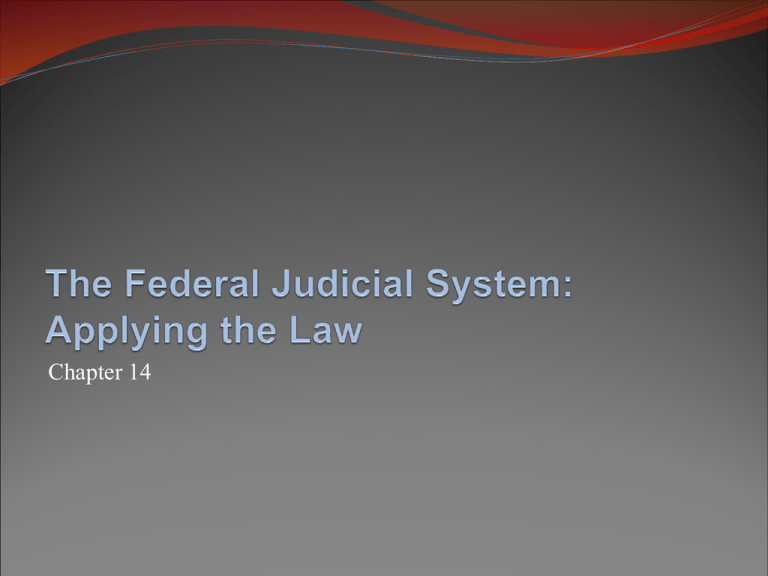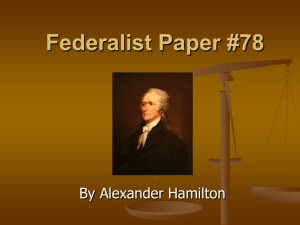
Chapter 14
The Federal Judicial System
The Supreme Court of the United States
Selecting and deciding cases
Issuing decisions and opinions
Majority
Plurality
Concurring
Dissenting
© 2015, McGraw-Hill Education. All Rights Reserved.
2
© 2015, McGraw-Hill Education. All Rights Reserved.
3
The Federal Judicial System
Other federal courts
U.S. district courts
U.S. courts of appeals
Special U.S. courts
The state courts
Political appointment
Elected judges (most common form)
Merit-plan judges
© 2015, McGraw-Hill Education. All Rights Reserved.
4
© 2015, McGraw-Hill Education. All Rights Reserved.
5
© 2015, McGraw-Hill Education. All Rights Reserved.
6
Federal Court Appointees
Supreme Court nominees
Presidents nominate those with compatible political
philosophy
Nominees must be acceptable to others
Very few nominees rejected by Senate after nineteenth
century
© 2014, McGraw-Hill Education. All Rights Reserved.
7
Federal Court Appointees
Lower-court nominees
Senatorial courtesy
Presidents typically select members of same party
Personal backgrounds of judicial appointees
Nearly all recent appointees from appellate courts
Most are white men, but diversity has increased in recent
decades
© 2015, McGraw-Hill Education. All Rights Reserved.
8
© 2014, McGraw-Hill Education. All Rights Reserved.
© 2015, McGraw-Hill Education. All Rights Reserved.
10
The Nature of
Judicial Decision Making
Legal influences on judicial decisions
The facts of a case
Three main sources of law
The Constitution
Legislative statutes
Legal precedents
© 2015, McGraw-Hill Education. All Rights Reserved.
11
© 2015, McGraw-Hill Education. All Rights Reserved.
12
The Nature of
Judicial Decision Making
Political influences on judicial decisions
Inside the Court: judges’ political beliefs
Justices vote in line with their political attitudes
Not all issues clear-cut
© 2015, McGraw-Hill Education. All Rights Reserved.
13
The Nature of
Judicial Decision Making
Political influences on judicial decisions
Outside the Court: the public, groups, and elected officials
Court cannot move too far from public opinion
Interest groups
Congressional legislation and presidential appointments
© 2015, McGraw-Hill Education. All Rights Reserved.
14
Judicial Power and
Democratic Government
Originalism theory versus living constitution theory
Originalism: determine and preserve founders’ intent
Living constitution: adaptable to changing social situation
© 2015, McGraw-Hill Education. All Rights Reserved.
15
Judicial Power and
Democratic Government
Judicial restraint versus judicial activism
Restraint: judges should abide by precedent and legislation
Activism: judges should interpret Constitution and statutes
in light of established principles when elected officials fail
to do so
What is the judiciary’s proper role?
© 2014, McGraw-Hill Education. All Rights Reserved.
16







